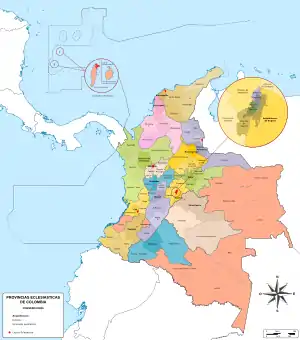Catholic Church in Colombia
The Catholic Church in Colombia is the branch of the Roman Catholic Church in the South American nation of Colombia.
| Part of a series on the |
| Catholic Church by country |
|---|
.svg.png.webp) |
|
|

Organization
It is organized into 13 ecclesiastical provinces, subdivided into 13 archdioceses and 52 dioceses, and a Maronite apostolic exarchate. Over 120 religious orders, institutes, and lay organizations run hundreds of primary and secondary schools, hospitals, clinics, orphanages, colleges, and 8 universities across the country. The best known is Pontificia Universidad Javeriana (in Cali) and Pontificia Universidad Javeriana (in Bogotá), both Jesuit universities.[1]
Based on studies and a survey, about 90% of the Colombian population adheres to Christianity, the majority of which (70.9%) are Catholic, while 16.7% adhere to Protestantism (primarily Evangelicalism).[2][3][4]
History
Catholicism was introduced to the country 1508. Two dioceses were organized in 1534. The Church grow significantly by the mid-17th century, in spite of the variety of Indian languages, government interference and competition among religious orders. Some persecution followed the declaration of independence, in 1819.
Throughout Latin America, the Church was subject to Spain and served its purposes throughout the colonial period and part of the nineteenth century. It was responsible for founding and directing schools for educating native elites (San Bartolome, El Rosario and the University of St. Thomas), creating and sustaining hospitals, help from the colonial bureaucracy and generally, as an instrument of control and social cohesion.
In the late eighteenth century, the Bourbon reforms began to break down this scheme, especially with respect to education. For the first time the usefulness of the scholastic system used until then was questioned, and changes were sought.
At Independence, the clergy split between those who supported the king (royalists) and those who preferred absolute independence (nationalists). The high clergy (bishops and dignitaries) supported the former, while parish priests and many of the religious, supported the latter. The role played by the clergy in Independence was decisive, because it contributed to the mobilization and recruitment of fighters; they served as chaplains and military leaders.
With the Constitution of Colombia of 1991 the Colombian State was no longer Catholic. Equality and religious freedom were recognized.
On June 22, 2012, media in Colombia, published the report titled "The Pope is concerned about the penetration of Pentecostals in Colombia" where religious pluralism merited serious consideration. The increasingly active presence of Pentecostal and Evangelical communities in many parts of Latin America were eviden.
On October 31, 2012 Bishop Juan Vicente Córdoba, Secretary General of the Colombian Episcopal Conference, announced that the Catholic Church would seek parishioners in shopping centers, placing parishes in these commercial establishments. 4
Mariano de Jesus Euse Hoyos (the "father Marianito") and 7 religious of San Juan de Dios were beatified while Mother Laura Montoya, founder of the Missionaries of Mary Immaculate and St. Catherine of Siena (lauritas), was canonized.
Influence
Catholicism wielded a strong influence on public opinion and government affairs. The Church influences various fields and institutions, including:
- Military and Police–The Bishopric of Colombia Castrense serves exclusively as staff diocese to active and retired staff and family members of the Colombian Armed Forces and the National Police.
- The Apostolic Nunciature–the embassy of the Holy See in the country.
- The faithful–representing about 90% of the population.
- Churches–land acquisition and construction
- The Concordat with the Holy See came into force in 1886; the Constitutional Court enforced some of its provisions in 1993. The Colombian Bishops ' Conference spoke against it two weeks later.
See also
Notes
- Annuario Pontificio, 2009.
- Beltrán Cely, William Mauricio. "Del monopolio católico a la explosión pentecostal'" (PDF) (in Spanish). Universidad Nacional de Colombia, Facultad de Ciencias Humanas, Centro de Estudios Sociales (CES), Maestría en Sociología. ISBN 978-958-761-465-7. Archived from the original (PDF) on 2016-03-27. Retrieved 2016-05-18.
- Beltrán Cely, William Mauricio. "Descripción cuantitativa de la pluralización religiosa en Colombia" (PDF). Universitas humanística 73 (2012): 201–238. – bdigital.unal.edu.co. Archived from the original (PDF) on 2014-03-29. Retrieved 2016-05-18.
- "Religion in Latin America, Widespread Change in a Historically Catholic Region". pewforum.org. Pew Research Center. November 13, 2014.